| 33344-33434 tilings | ||
|---|---|---|
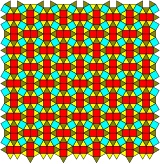  Faced colored by their symmetry positions | ||
| Type | 2-uniform tiling | |
| Designation | 1 | 2 |
| Vertex configurations | 3.3.4.3.4 and 3.3.3.4.4 | |
| Symmetry | p4g, , (4*2) | pgg, , (22×) |
| Rotation symmetry | p4, , (442) | p2, , (2222) |
| Properties | 4-isohedral, 5-isotoxal | 3-isohedral, 6-isotoxal |
In geometry of the Euclidean plane, a 33344-33434 tiling is one of two of 20 2-uniform tilings of the Euclidean plane by regular polygons. They contains regular triangle and square faces, arranged in two vertex configuration: 3.3.3.4.4 and 3.3.4.3.4.
The first has triangles in groups of 3 and square in groups of 1 and 2. It has 4 types of faces and 5 types of edges.
The second has triangles in groups of 4, and squares in groups of 2. It has 3 types of face and 6 types of edges.
Geometry
Its two vertex configurations are shared with two 1-uniform tilings:
3.3.4.3.4 |
 3.3.3.4.4 |
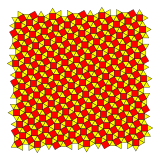 snub square tiling |
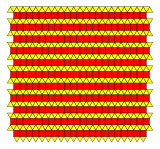 elongated triangular tiling |
Circle Packings
These 2-uniform tilings can be used as a circle packings.
In the first 2-uniform tiling (whose dual resembles a key-lock pattern): cyan circles are in contact with 5 other circles (3 cyan, 2 pink), corresponding to the V3.4 planigon, and pink circles are also in contact with 5 other circles (4 cyan, 1 pink), corresponding to the V3.4.3.4 planigon. It is homeomorphic to the ambo operation on the tiling, with the cyan and pink gap polygons corresponding to the cyan and pink circles (mini-vertex configuration polygons; one dimensional duals to the respective planigons). Both images coincide.
In the second 2-uniform tiling (whose dual resembles jagged streams of water): cyan circles are in contact with 5 other circles (2 cyan, 3 pink), corresponding to the V3.4 planigon, and pink circles are also in contact with 5 other circles (3 cyan, 2 pink), corresponding to the V3.4.3.4 planigon. It is homeomorphic to the ambo operation on the tiling, with the cyan and pink gap polygons corresponding to the cyan and pink circles (mini-vertex configuration polygons; one dimensional duals to the respective planigons). Both images coincide.
| C1 | a3.4; 3.4.3.4]1 | C2 | a2 |
|---|---|---|---|
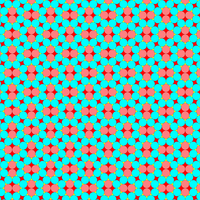
|

|

|

|
Dual tilings
The dual tilings have right triangle and kite faces, defined by face configurations: V3.3.3.4.4 and V3.3.4.3.4, and can be seen combining the prismatic pentagonal tiling and Cairo pentagonal tilings.
| Faces | 1-uniform | 2-uniform | ||
|---|---|---|---|---|
| V3.3.3.4.4 | V3.3.4.3.4 | V3.3.3.4.4 and V3.3.4.3.4 | ||
 V3.3.3.4.4 80px V3.3.4.3.4 |
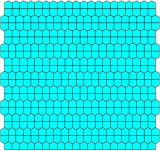 prismatic pentagonal tiling |
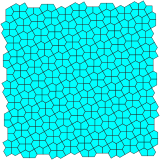 Cairo pentagonal tiling |
 Dual tiling I |
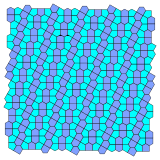 Dual tiling II |
Notes
- Grünbaum, Branko; Shephard, G. C. (1987). Tilings and Patterns. W. H. Freeman. ISBN 0-7167-1193-1. p. 65-67
- Chavey (1989)
References
- Keith Critchlow, Order in Space: A design source book, 1970, pp. 62–67
- Ghyka, M. The Geometry of Art and Life, (1946), 2nd edition, New York: Dover, 1977. Demiregular tiling #15
- Williams, Robert (1979). The Geometrical Foundation of Natural Structure: A Source Book of Design. Dover Publications, Inc. ISBN 0-486-23729-X. pp. 35–43
- Sacred Geometry Design Sourcebook: Universal Dimensional Patterns, Bruce Rawles, 1997. pp. 36–37
- Introduction to Tessellations, Dale Seymour, Jill Britton, (1989), p.57, Fig 3-24 Tessellations of regular polygons that contain more than one type of vertex point
External links
- Chavey, D. (1989). "Tilings by Regular Polygons—II: A Catalog of Tilings". Computers & Mathematics with Applications. 17: 147–165. doi:10.1016/0898-1221(89)90156-9.
- Dutch, Steve. "Uniform Tilings". Archived from the original on 2006-09-09. Retrieved 2006-09-09.
- Weisstein, Eric W. "Demiregular tessellation". MathWorld.
- In Search of Demiregular Tilings, Helmer Aslaksen
- n-uniform tilings Brian Galebach, 2-Uniform Tiling 1 of 20